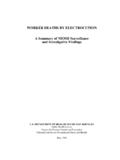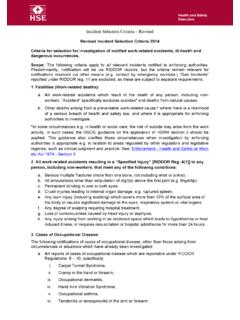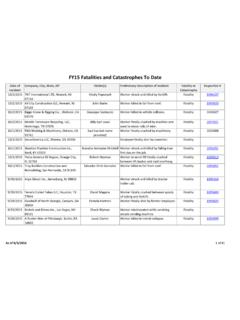Transcription of Heat-Related Deaths - United States Environmental ...
1 Climate Change Indicators in the United States : Heat-Related Deaths - Updated August 2016 1 Heat-Related Deaths This indicator presents data on Deaths classified as Heat-Related in the United States . Background When people are exposed to extreme heat , they can suffer from potentially deadly illnesses, such as heat exhaustion and heat stroke. Hot temperatures can also contribute to Deaths from heart attacks, strokes, and other forms of cardiovascular disease. heat is the leading weather- related killer in the United States , even though most Heat-Related Deaths are preventable through outreach and intervention (see EPA s Excessive heat Events Guidebook at: ).
2 Unusually hot summer temperatures have become more common across the contiguous 48 States in recent decades1 (see the High and Low Temperatures indicator), and extreme heat events ( heat waves) are expected to become longer, more frequent, and more intense in the As a result, the risk of Heat-Related Deaths and illness is also expected to Reductions in cold- related Deaths are projected to be smaller than increases in Heat-Related Deaths in most death rates can also change, however, as people acclimate to higher temperatures and as communities strengthen their heat response plans and take other steps to continue to adapt.
3 Certain population groups already face higher risks of Heat-Related death , and increases in summertime temperature variability will increase that ,6 T he population of adults aged 65 and older, which is expected to continue to grow, has a higher-than-average risk of Heat-Related death . Children are particularly vulnerable to Heat-Related illness and death , as their bodies are less able to adapt to heat than adults, and they must rely on others to help keep them People with certain diseases, such as cardiovascular and respiratory illnesses, are especially vulnerable to excessive heat exposure, as are the economically disadvantaged.
4 Data also suggest a higher risk among non-Hispanic About the Indicator This indicator shows the annual rate for Deaths classified by medical professionals as Heat-Related in the United States based on death certificate records. Every death is recorded on a death certificate, where a medical professional identifies the main cause of death (also known as the underlying cause), along with other conditions that contributed to the death . These causes are classified using a set of standard codes. Dividing the annual number of Deaths by the population in that year, then multiplying by one million, will result in the death rates (per million people) that this indicator shows.
5 Figure 1 shows Heat-Related death rates using two methods. One method shows Deaths for which excessive natural heat was stated as the underlying cause of death from 1979 to 2014. The other data series shows Deaths for which heat was listed as either the underlying cause or a contributing cause, based on a broader set of data that, at present, can only be evaluated back to 1999. For example, in a case where cardiovascular disease was determined to be the underlying cause of death , heat could be Climate Change Indicators in the United States : Heat-Related Deaths - Updated August 2016 2 listed as a contributing factor because it can make the individual more susceptible to the effects of this disease.
6 Because excessive heat events are associated with summer months, the 1999 2014 analysis was limited to May through September. Figure 2 offers a closer look at cardiovascular disease Deaths for which heat was recorded as a contributing cause. This graph includes Deaths due to heart attacks, strokes, and other diseases related to the circulatory system. Figure 2 shows death rates for the overall population as well as two groups with a higher risk: people age 65 and older and non-Hispanic blacks. Like the underlying and contributing causes analysis in Figure 1, Figure 2 is restricted to the summer months, and it uses data that are available from 1999 to 2014.
7 Key Points Between 1979 and 2014, the death rate as a direct result of exposure to heat (underlying cause of death ) generally hovered around to 1 Deaths per million people, with spikes in certain years (see Figure 1). Overall, a total of more than 9 ,000 Americans have died from Heat-Related causes since 1979, according to death certificates. For years in which the two records overlap (1999 2014), accounting for those additional Deaths in which heat was listed as a contributing factor results in a higher death rate nearly double for some years compared with the estimate that only includes Deaths where heat was listed as the underlying cause (see Figure 1).
8 The indicator shows a peak in Heat-Related Deaths in 2006, a year that was associated with widespread heat waves and was one of the hottest years on record in the contiguous 48 States (see the and Global Temperature indicator). The death rate from Heat-Related cardiovascular disease ranged from Deaths per million people in 2004 to Deaths per million people in 1999 (see Figure 2). Overall, the interaction of heat and cardiovascular disease caused about one-fourth of the Heat-Related Deaths recorded in the underlying and contributing causes analysis since 1999 (see Figures 1 and 2).
9 Since 1999, people aged 65+ have been several times more likely to die from Heat-Related cardiovascular disease than the general population, while non-Hispanic blacks generally have had higher-than-average rates (see Figure 2). Examination of extreme events has revealed challenges in capturing the full extent of Heat-Related Deaths . For example, studies of the 1995 heat wave event in Chicago (see example figure) suggest that there may have been hundreds more Deaths than were actually reported as Heat-Related on death certificates. While dramatic increases in Heat-Related Deaths are closely associated with the occurrence of hot temperatures and heat waves, these Deaths may not be reported as Heat-Related on death Climate Change Indicators in the United States : Heat-Related Deaths - Updated August 2016 3 certificates.
10 This limitation, as well as considerable year-to-year variability in the data, make it difficult to determine whether the United States has experienced a meaningful increase or decrease in Deaths classified as Heat-Related over time. Figure 1. Deaths Classified as Heat-Related in the United States , 1979 2014 This figure shows the annual rates for Deaths classified as Heat-Related by medical professionals in the 50 States and the District of Columbia. The orange line shows Deaths for which heat was listed as the main (underlying) cause.* The blue line shows Deaths for which heat was listed as either the underlying or contributing cause of death during the months from May to September, based on a broader set of data that became available in 1999.














